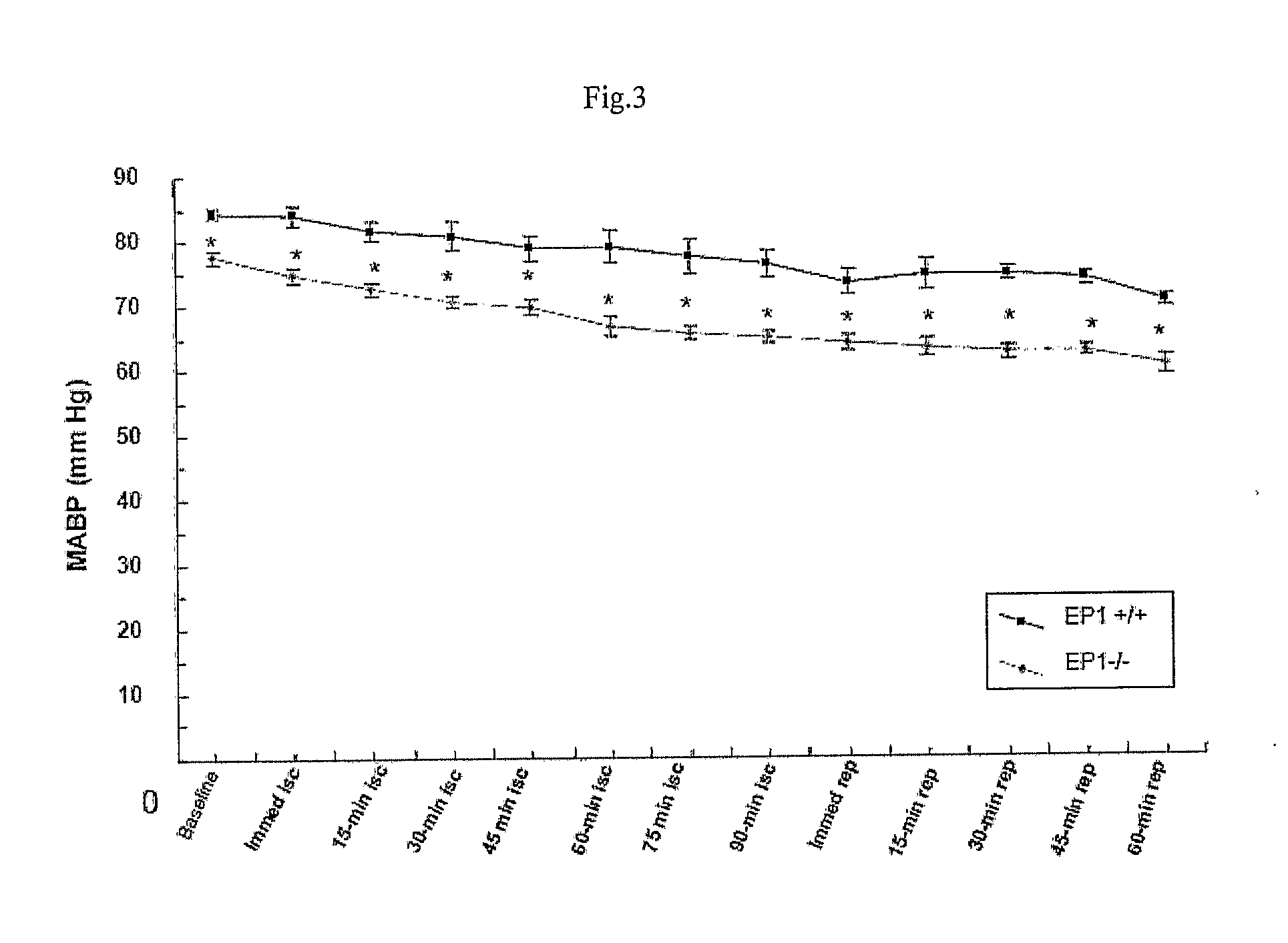Method for the Prevention and/or Treatment of Neurodegenerative Diseases Characterized by Administering and Ep1 Receptor Antagonist
a neurodegenerative disease and receptor antagonist technology, applied in the direction of elcosanoid active ingredients, peptide/protein ingredients, drug compositions, etc., can solve the problem of not knowing whether ep1 is ep1 /sub>1, the effect of other than the desired effect turns into a side effect, and it is difficult to know whether ep1 is ep1 or not, etc., to achieve the effect of low toxicity
- Summary
- Abstract
- Description
- Claims
- Application Information
AI Technical Summary
Benefits of technology
Problems solved by technology
Method used
Image
Examples
example 1
The Prostaglandin PGE2 EP1 Receptor Knockout Mice Attenuate Ischemia Reperfusion Injury
Materials and Methods
[0111]This study was conducted in accordance with the National Institutes of Health guidelines for the use of experimental animals. Protocols were approved by the Institutional Animal Care and Use Committee at Johns Hopkins University. [C57BL / 6] Male mice were divided into two groups: EP1+ / + and EP1− / −, each having 12 animals. The animals of each group were sacrificed after 4 days of reperfusion and brains were dissected for TTC staining.
Middle Cerebral Artery Occlusion and Reperfusion
[0112]Transient focal cerebral ischemia was induced by MCAO using an intraluminal filament technique. Under halothane anesthesia (2.0% for induction, 1.0% for maintenance), adult male mice (20-28 g at 8-10 weeks old) were ventilated with oxygen-enriched air via a nose cone. Body temperatures were maintained between 36.0-38.8° C. by a heating pad. Relative cerebral blood flow (CBF) was measured by...
example 2
The Effect of an EP1 Receptor Antagonist in the Treatment of Neurodegenerative Diseases, Using Wildtype and EP1− / − Mice
Materials and Methods
Chemicals:
[0120]Unless stated otherwise, all chemicals were purchased from Sigma Co. (St. Louis, Mo.).
compound A (EP1 receptor agonist):
(4-({(1R,2R,3R)-3-hydroxy-2-[(1E,3S,5S)-3-hydroxy-5-methylnon-1-enyl]-5-oxocyclopentyl}acetyl)cyclohexanecarboxylic acid) was prepared according to a method described in JP11-322709 and compound B (EP1 receptor antagonist):
((2E)-3-(4-{[2-[(2-furylsulfonyl)(isobutyl)amino]-5-(trifluoromethyl)phenoxy]methyl}phenyl)acrylic acid) was prepared according to a method described in the specification of WO 02 / 72564.
Mice:
[0121]Following protocols approved by the Institutional Animal Care and Use Committee of Johns Hopkins University, adult male C57BL / 6 mice (Charles River, Wilmington, Mass.) and EP1− / −, weighing 20-25 g were used in this study.
Treatment of Mice:
[0122]Weight and rectal temperature of each mouse was recorded...
formulation example 1
[0128]The following components (1) to (4) were admixed by a conventional method, punched out by a conventional method to give 100 tablets each containing 5 mg of active ingredient.
(1) 3-methyl-4-[2-[N-isobutyl-N-(5-methyl-2-furylsulfonyl)amino]-4,5-dimethyl phenoxymethyl]benzoic acid 500 mg
(2) calcium carboxymethylcellulose (disintegrating agent) 200 mg
(3) magnesium stearate (lubricant) 100 mg
(4) microcrystalline cellulose 9.2 g
PUM
| Property | Measurement | Unit |
|---|---|---|
| body temperature | aaaaa | aaaaa |
| concentration | aaaaa | aaaaa |
| pharmaceutical composition | aaaaa | aaaaa |
Abstract
Description
Claims
Application Information
 Login to View More
Login to View More - R&D
- Intellectual Property
- Life Sciences
- Materials
- Tech Scout
- Unparalleled Data Quality
- Higher Quality Content
- 60% Fewer Hallucinations
Browse by: Latest US Patents, China's latest patents, Technical Efficacy Thesaurus, Application Domain, Technology Topic, Popular Technical Reports.
© 2025 PatSnap. All rights reserved.Legal|Privacy policy|Modern Slavery Act Transparency Statement|Sitemap|About US| Contact US: help@patsnap.com



